Kalevala Event
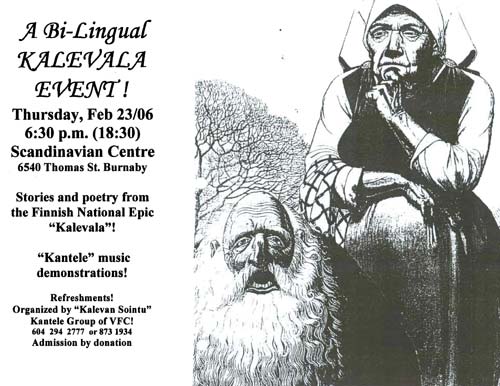

February 22, 2006 in Culture, Folk Legends & Myths, Music by Marja-Leena Comments Off on Kalevala Event
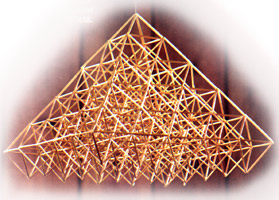
(A straw moble or “himmeli” – scanned from a clipping in my files, from an old Finnish magazine possibly Kotiliesi)
It’s now five nights to Christmas Eve and my thoughts are dancing around this rather magical time. I’m really enjoying reading Christmas themed sites and blogs, even looking back at my own of a year ago, such as the one about my favourite things and winter lights. Maybe being a bit childish helps me to recapture happy memories and puts me into the Christmas mood, so call me sentimental, I don’t mind!
Anni at Mayday 34°35’S 150°36’E* writes about where Santa really lives: Everybody knows Santa does not live on the North Pole, he lives in Finland at Korvatunturi mountain. That’s in Finnish Lapland, and it’s an enjoyable site to visit (in English and Finnish), especially if you have young children with whom to share the activities. The illustrations and stories are charming. I love the straw mobile or “himmeli”, a traditional Finnish decoration made of dried straw, an example of one style shown above.
Anni’s post received some lively comments, including Anni’s own delightful response:
I should have made this perfectly clear from the beginning. The Santa – who is not called Santa but Joulupukki (Christmas Goat, originally a very pagan creature complete with a beard and horns) – visits Finns in person, interrogates the children about their end-of-school-term marks and whether or not they have been good or bad. And if they have been good and if they sing him a special Joulupukki song, they’ll get the presents. Otherwise not. The rest of the year he sends his spies, elves, around to check and report about children’s behaviour. It is a great thing for the parents, they are able to refer to the elves’ and Joulupukki’s authority in problem situations by warning that, come Christmas, they won’t get presents, only bare twigs from a tree (for beating the bad, you see). This, in my opinion, is the reason for Finnish children’s good literacy and numeracy skills in all international surveys.
UPDATE December 16, 2013: * Anni’s blog is no longer online, sadly. The Korvatunturi site has since been updated and redesigned dramatically. The ‘himmeli’ link is no longer there.
December 19, 2005 in Culture, Finland, Estonia & Finno-Ugric, Folk Legends & Myths by Marja-Leena 2 Comments »
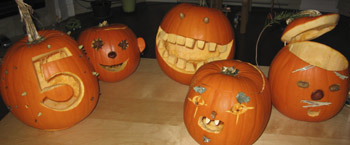
(photo – EKR)
Tonight is Halloween and all the little boys and girls will be out trick-or-treating. Our granddaughter is coming over to visit a few houses, then help answer the door in her “ghost princess” costume and scare the callers! Little children with their excitement in role play make Halloween special for me, not the whole commercialization of an ancient custom (as I complained a year ago).
Leslee of Third House Party wrote a lovely post, along with fabulous photos, about pumpkins and the annual Pumpkin Festival in the town of Keene, New Hampshire, USA which currently holds the world record for the most lit pumpkins in one location. And Amy of “ever so humble”, also in New Hampshire, defines lanterns.
Finnish readers will enjoy reading Anna Amnell’s posts on the tradition of Halloween and adult Americans’ super early Halloween craze as a form of escapism from the stresses created by a media mix of murders and trivia (“Horrible-Beautiful Breakfast Mix”). She finishes with a link to James Joyce’s The Dead which reveals that for Irish and Anglo Americans Halloween is really about the acceptance of death.
This sounds to me rather like the Day of the Dead in Mexico.
More interesting seasonal links can be found at Samhain, Halloween & Day of the Dead. Have a happy and safe Halloween!
UPDATE Nov.3.05. An interesting article in National Geographic on how Mexicans celebrate Día de los Muertos, or Day of the Dead.
October 31, 2005 in Culture, Folk Legends & Myths by Marja-Leena 5 Comments »

Detail of birds, Malagan Pole
19th century Papua New Guinea
Myths are stories that explain why the world is the way it is. All cultures have them. Throughout history, artists have been inspired by myths and legends and have given them visual form. Sometimes these works of art are the only surviving record of what particular cultures believed and valued. But even where written records or oral traditions exist, art adds to our understanding of myths and legends.
This is from World Myths and Legends in Art from the Minneapolis Institute of Arts, a fascinating online museum type exhibition with a wealth of information.
In the absence of scientific information of any kind, long ago societies all over the world devised creation myths, resurrection myths, and complex systems of supernatural beings, each with specific powers, and stories about their actions. Since people were often isolated from each other, most myths evolved independently, but the various myths are surprisingly similar, in particular creation myths….
As the richness of the myths represented in this collection conveys, myth and falsehood are not synonymous. What is truth to one is fancy to another; however, it is not up to any of us to decide that one community’s mythology is any more or less valid than another’s. Myth is a positive force that unites many cultures rather than divides them. Throughout the world myths provide people with explanations, histories, role models, entertainment, and many other things that enable them to direct their own actions and understand their own surroundings.
You can view the many examples of art by theme or by culture. For example, the story behind the Malagan Pole is a fascinating one (detail above).
September 3, 2005 in Anthropology, Culture, Folk Legends & Myths by Marja-Leena 3 Comments »
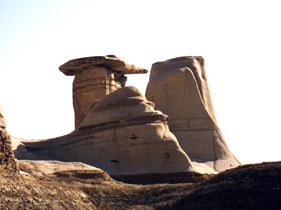
Hoodoos near Drumheller – photo by Marja-Leena
A few days ago I found Anita Konkka’s fascinating writer’s dairy. I quickly became absorbed reading the beautifully written entries, in a Finnish that I was able to understand and enjoy easily. (I’ve sometimes been frustrated not understanding today’s slang used by many Finnish bloggers.)
Anita Konkka is the author of many novels, essays, radio-plays, and a dream-book. Some of her novels address the question of Ingrian identity because of her father’s roots (the Ingrian Finns are from around St. Petersburg). Other novels are richly informed by dream studies and diverse cultural mythologies. An English translation of “In the Fool’s Paradise” is forthcoming (Dalkey Archive Press, 2006) which I will definitely look for in the North American market. I must try to get some of her Finnish books in the meantime! English readers will enjoy Anita’s excerpts of her writings at her literary website.
Attracted by her interest in dreams, myths and culture, including that of Russia, I emailed her and was very pleasantly surprised to receive a nice reply. Anita expressed fascination for the hoodoos in my “Silent Messengers” prints and had several good questions, which I think might interest my regular readers too.
What are hoodoos? These are geological formations of weathered rock in columnar or pillar forms and sometimes with caps. The Writing-on-Stone Provincial Park website has a good explanation as does Wikipedia.
Do the hoodoos have native petroglyphs or pictographs? “For hundred of years, the Blackfoot people visited this valley and believed that this amazing place was sacred and the home of spirits. Although it is rare for rock art to be found on hoodoos, there are both pictographs and petroglyphs upon the sandstone cliffs along the Milk River” in Writing on Stone Provincial Park. This is why I am still planning to visit these sites.
Is “hoodoo” an aboriginal word? This question stumped me as I’d not seen anything about its etymology. Googling found another writer, this time Canadian Bill Casselman, a broadcaster and the author of many books on Canadian words, sayings and names. He wrote an interesting story behind the word “hoodoo” and how it has nothing to do with “voodoo” as others have claimed. Here’s an excerpt:
“American aboriginal peoples of the northwest picked up the word hoodoo from English-speaking fur trappers and, like them, used hoodoo to refer to any malignant creature or evil supernatural force. That’s how it came to be applied to the curious columns of earth or rock. For they were thought to be evil in the mythologies of many first peoples. But, borrowing works in the other direction as well. For example, in Siksika (Blackfoot) mythology, the strange hoodooesque shapes were giants whom the Great Spirit had turned to stone because of their evil deeds. Deep in the night, the petrified giants could awaken and throw boulders down upon any humans passing nearby.”
No wonder hoodoos are such an attraction to artists and writers! Thanks to new virtual friend, Anita, for the great questions!
July 8, 2005 in Being an Artist, Folk Legends & Myths, Photoworks, Rock Art & Archaeology, Rocks by Marja-Leena Comments Off on writers and hoodoos
The much-anticipated stage adaptation of J.R.R. Tolkien’s ‘The Lord of the Rings’ trilogy will have its world premiere in Toronto, producers announced in London Tuesday. The $27-million show, co-produced by Toronto’s Mirvish Productions, will open in March 2006 at the Princess of Wales Theatre with a largely Canadian cast […] The show had been scheduled to debut in London this spring […] However, there was no theatre available to accommodate the massive and technically complex three-hour production. (from CBC.ca*)
Last year I wrote about some interesting Finnish connections to the ‘Lord of the Rings’. First it was about Tolkien’s study of the Finnish language and the Kalevala. Then I wrote about the contributions of Finnish culture including folk group Värttinä’s music to the stage adaptation musical of the ‘Rings’.
Now I also discover several Canadian connections, including a Canadian creator of the music score and composer of a Rings symphony:
The music is by Bollywood composer A.R. Rahman, responsible for the U.K. hit Bombay Dreams, and Finnish group Värttinä’.[…] The Canadian Children’s Opera Chorus produced an opera adaptation of Tolkien’s The Hobbit last summer and Toronto-born composer Howard Shore, who created the score for Jackson’s films, adapted his music into a symphony work entitled The Lord of the Rings: A Symphony in Six Movements for Orchestra and Chorus. The piece has been performed to sold-out audiences around the world.
Some further reading in news around the world:
more in CBC*
BBC
the Aussie news*
Kaleva.plus in Finnish*
Thanks to a new reader in Finland who sent me a scanned clipping of the news item from the print version of Helsingin Sanomat. Now, I wonder if my cousin in Toronto has a spare bedroom?
** Updated 27.08.2015 – expired links removed
March 17, 2005 in Books, Films, Finland, Estonia & Finno-Ugric, Folk Legends & Myths, Music by Marja-Leena 2 Comments »
A news item in VietNam News, via News Room Finland** caught my eye – “Finnish oral traditions inspire painting exhibition in Ha Noi” (links are mine):
“Two female artists from Viet Nam and Hungary are displaying their interpretations of Finnish folklore in an ongoing exhibition called Kantelatar in Ha Noi. The original Kantelatar* contains more than 600 lyrics and ballads and is the companion work to the Finnish national epic, the Kalevala. Both works were compiled by scholar-physician Elias Lönnrot from poetry passed on by word of mouth over many centuries. The Kantelatar expresses the emotions of Finnish people in daily life and festivals.
The Juminko Foundation of Finland invited two foreign artists to illustrate the Kantelatar with paintings, and some pieces from the work were translated into Hungarian and Vietnamese. […] Sponsored by the EU, the Finnish government and the embassies of Hungary and Viet Nam, the exhibition was held in Budapest before it came to Ha Noi.”
Now, the Hungarians are very distant cousins of the Finns, but the Vietnamese connection is unusual and most intriguing here.
If you’re interested, Virtual Finland** has lots more links about the Kalevala, which inspired many artists and composers.
**Virtual Finland no longer exists, sadly
March 14, 2005 in Art Exhibitions, Finland, Estonia & Finno-Ugric, Folk Legends & Myths by Marja-Leena Comments Off on Finnish folklore inspires

Illustration by Rudolf Koivu, “The troll and the shepherdess” in “Matka Satumaahan” (A Trip to the Land of Fairytales) by Raul Roine, Otava, Helsinki 1954
Sometimes I wonder if some readers think I’m silly when I write about my interest in folk legends, myths and fairy tales. I enjoy these for some light-hearted posts to intermingle with all this serious art stuff and to please my inner child, right?
Well, this item in Helsingin Sanomat International makes me feel a lot more intelligent:
Finland has received what appears to be the first doctoral dissertation on traditional forest trolls. Master of Philosophy Camilla Asplund Ingemark, 30, has researched the subject for six years. She will defend her doctoral dissertation, which is classified as a work on folklore, at the Åbo Akademi University in Turku on Friday. The study describes the world of trolls according to the beliefs in the folklore of Swedish-speaking Finns.
This doctoral dissertation is a part of a broader magic and troll boom in literature and the visual arts. The adventures of trolls were also recounted in the novel Ennen päivänlaskua ei voi (‘Before sundown you cannot’) by Johanna Sinisalo. Her trolls are a species that is a cross of cats and monkeys. Sinisalo was awarded the Finlandia Prize for her work in 2000.
The troll has been seen as a humorous phenomenon or a symbol of fears.
But Tove Jansson’s ultra-sympathetic Moomintroll is a different story altogether.
Facts about Trolls & Witches
Moominworld and author Tove Jansson* (link has since expired)
Not Before Sundown (Troll) by Johanna Sinisalo
And who can forget The Lord of the Rings phenomena!
February 4, 2005 in Books, Finland, Estonia & Finno-Ugric, Folk Legends & Myths by Marja-Leena 7 Comments »
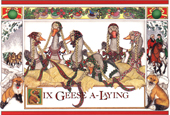
Six Geese A-Laying, Illustration by Jan Brett on a Christmas card, from the book The Twelve Days of Christmas, published by Dodd, Mead & Co., NY
A little bit of whimsy, forgive me, as some ever so slight relief from the heavy hearts we feel over this week’s immense tragedies….
A faint memory from childhood has been teasing me, an image of my mother saying that the Christmas tree should stay up until the twelfth day of Christmas. A search led to Wikipedia: The Twelve Days of Christmas are the days from December 26 to January 6, or the Epiphany, also called ‘Twelfth Day’, culminating that night in ‘Twelfth Night’.**
But, back then the tree was not put up until Christmas Eve. As adults now we usually put up ours about a week before Christmas, and many others put theirs up in the beginning of December. How traditions change!
So, according to the carol The Twelve Days of Christmas**, my true love shall be bringing me ‘Six geese a-laying’! An interesting fact about this song is that the total number of presents given (counting 12 partridges, 11 turtle doves…) is 364 which is 1 less than the number of days in a year.
Then this item jogged another memory from childhood of New Year’s eves, though Finnish not German:
In Germany people would drop molten lead into cold water and try to tell the future from the shape it made. A heart or ring shape meant a wedding, a ship a journey, and a pig plenty of food in the year ahead. I wonder if any Finns or Germans do this anymore today.
And so, friends, it is New Year’s Eve on this sixth day of Christmas. Have a healthy and peaceful, creative and giving NEW YEAR 2005! Let us hope for relief, restoration of life’s necessities and peace for all the needy in this world. (Ooh, my, I just realized that it is also six days since the earthquake and tsunami in Asia!)
UPDATED Jan.05.05 Just found out that Epiphany (Twelfth Day) is a national holiday in Finland. Now I understand why it was such a significant date for my mother!
December 31, 2004 in Culture, Folk Legends & Myths by Marja-Leena Comments Off on the sixth day
The winter solstice is again upon the Northern Hemisphere, and though the year’s shortest day heralds the onset of winter it also promises the gradual return of the sun after a prolonged period of darkness. That there are holidays at the time of this astronomical event is no coincidence. Since ancient times, people have celebrated the solstice and observed it with many different cultural and religious traditions. Some of them survive to the present day though not always in the form you might expect. Read more at National Geographic News
Candlegrove.com is a rather interesting site describing some of the ancient origins of winter solstice and of Yule or jul (or joulu in Finnish), which may have originated in Scandinavia. Note also the references to some of the ancient solstice architecture around the world, such as Stonehenge, Newgrange, and Maeshowe in the UK and the Sun Dagger of Chaco Canyon, New Mexico.
Update Dec.22.04: Anna L Conti has some really neat solstice photos and links, especially the Chumash rock painting as a seasonal marker. (Strange that we are thinking similar thoughts and referencing each other here!)
And if this subject really grabs your interest, check out Doug Alder’s “Drivel” on the Yule and other pagan celebrations.
December 21, 2004 in Culture, Folk Legends & Myths by Marja-Leena Comments Off on winter solstice
© Marja-Leena Rathje 2004-2024